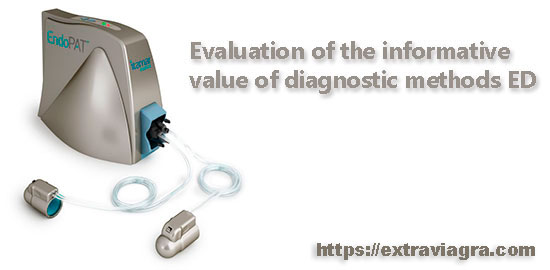Diagnostic ED: A large number of research papers on the physiology of erection and the pathophysiology of erectile dysfunction have been published, which have revealed the problem of studying the informativeness of diagnostic methods aimed at identifying the etiology of ED.
Currently, due to the wide choice of laboratory and instrumental diagnostic methods, the question arises about their irrational use, since some of them have insufficient information content and do not have diagnostic significance, and therefore do not play a special role in determining the further tactics of managing patients with erectile dysfunction. At the same time, it should be noted that the strategy for treating ED depends on the effectiveness and timeliness of diagnostic measures, and the delay in finding the causes of erectile disorders negatively affects the effectiveness of therapy.
To establish the etiopathogenetic mechanism of ED development, a comprehensive integrative approach is used, which implies step-by-step laboratory and instrumental studies. However, this does not always make it possible to obtain reliably significant information necessary for making a decision on the further plan of therapeutic and diagnostic measures.
The determination of diagnostic parameters that are highly specific and sensitive in determining the etiology of ED will reduce the frequency of unnecessary diagnostic measures and increase the accuracy of the really necessary diagnostic methods, which means that the optimal therapeutic tactics will be chosen.
Purpose of the study: To evaluate the informativeness of the diagnostic parameters used in determining the etiology of ED.
Materials and methods diagnostic ED
The study involved 465 men who complained about the inability to achieve and maintain an erection sufficient for sexual intercourse. The median age of the patients was 39 (30-49 years). The study did not include patients with cancer, autoimmune, or mental illnesses identified during the examination.
All participants underwent a step-by-step comprehensive diagnosis, including a clinical and anamnestic examination, a questionnaire (according to the questionnaire of the international index of erectile function 15), a physical and laboratory-instrumental examination. The results of a biochemical blood test (total protein, total bilirubin, creatinine, urea, alanine aminotransferase, aspartate aminotransferase, glucose) were evaluated with the determination of lipid (total cholesterol, high-and low-density lipoprotein cholesterol, triglycerides) and hormonal (total testosterone, sex hormone-binding globulin, estradiol, prolactin, and thyroid-stimulating hormone) profiles.
All patients underwent pharmacodopplerographic examination of the vessels of the penis using intracavernous injections of prostaglandin E1 (none of the patients had contraindications to this procedure). Diagnostic parameters such as the peak systolic blood flow rate in the cavernous arteries (Vmax a. cavernosa), the final diastolic blood flow rate in the cavernous arteries (Vend a. cavernosa), the index of resistance of the cavernous arteries, as well as the maximum speed and time of preservation of blood flow in the deep dorsal vein were evaluated.
All patients also underwent a non-invasive examination of the endothelial system function using a special EndoPat hardware complex with the determination of the value of the reactive hyperemia index, which allows us to assess the presence or absence of endothelial dysfunction.
Based on the results of the examination, the patients were divided into two groups for a consistent statistical analysis. The first group included 319 (68.6%) men with diagnosed organic forms of ED, the median age was 44 years. The second group included 146 (31.4%) men who had confirmed ED that was not associated with organic factors, the median age was 30 years.
Results
According to the results of the study, diagnostic parameters that are sufficiently informative make it possible to timely identify risk factors and pathological conditions underlying the etiology of ED, avoiding overdiagnosis. Diagnostic parameters that have unsatisfactory information content can be conditionally considered as additional if appropriate clinical data are available.
Through the consistent use of informative diagnostic parameters, it is possible to establish risk factors, as well as concomitant somatic diseases that are associated with the development of organic forms of ED, in order to determine further therapeutic and diagnostic tactics.

